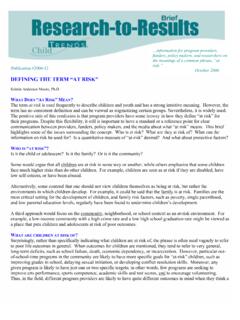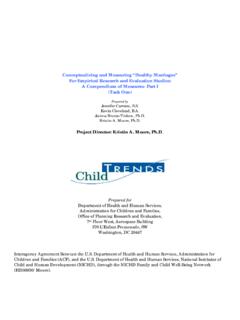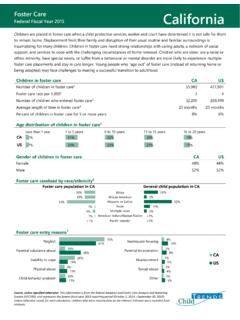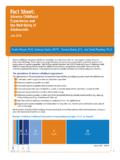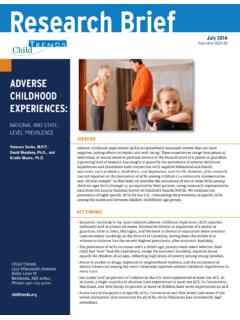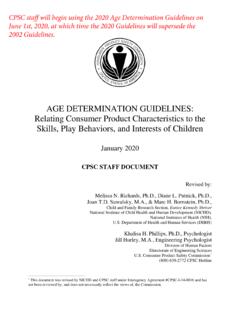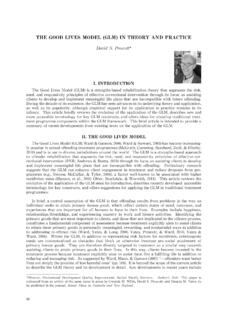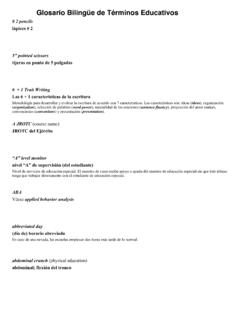Transcription of ASSESSING STRESS IN CHILDREN AND YOUTH: A GUIDE …
1 Information for practitioners on STRESS in CHILDREN and how to measure it. Publication #2010-22 October 2010. ASSESSING STRESS IN CHILDREN AND YOUTH: A GUIDE FOR OUT- OF-SCHOOL TIME PROGRAM PRACTITIONERS. Mary Terzian, , , Kristin A. Moore, , and Hoan N. Nguyen OVERVIEW. STRESS is unavoidable and can occur in all facets of life. At some level, STRESS can be seen as a natural part of development and of adaptation to a changing environment. Yet the implications of STRESS for CHILDREN and youth can be far-reaching, depending on its level and persistence. STRESS that is prolonged and managed poorly can result in negative physical, mental, and cognitive outcomes for CHILDREN and Experiencing high levels of STRESS or chronic STRESS can undermine physical health, for example, by increasing the likelihood of a weakened immune system, heart disease, obesity, and Other negative outcomes include anxiety, depression, poor memory and language skills, and lower academic ,4 Biological or genetic factors can increase one's vulnerability to STRESS , as can social and environmental factors.
2 For example, although STRESS can be problematic for CHILDREN and youth of all socioeconomic backgrounds, CHILDREN and youth from high-conflict families and those who live in high-crime, low-resource neighborhoods may be even more likely to experience chronic and/or high levels of To minimize the risk for negative health and behavioral development, it is important for families, schools, and program providers to be able to recognize and help CHILDREN cope with STRESS . Child Trends produced this brief to assist program providers in these efforts. For programs seeking to reduce STRESS in CHILDREN and youth, we also provide information about two well- validated measures of STRESS . WHAT IS STRESS ? STRESS results from the tension between an individual's reaction to difficulties or challenges and his or her ability to handle and resolve the stressful situation.
3 How people cope with STRESS depends on the resources that are available to them and whether they have the skills to utilize these resources. The term stressor relates to a challenging occurrence that may produce STRESS . Acute STRESS reflects short-lived STRESS or eventful experiences that occur once or multiple times. For example, acute STRESS can result from relocating to a new town or having a serious disagreement with a Whether these experiences result in negative or positive impacts on health and development depends on how one perceives and copes with the stressful experience. Acute STRESS that results from an unforeseen external event or significant life changes (such as a death of a parent, changing homes or schools, or being in a car accident) can be particularly upsetting because the individual experiencing this STRESS does not have control over the event, and many such events are very serious.
4 Chronic STRESS is an ongoing form of STRESS that occurs as a part of one's daily life and that continually taxes one's physical and mental resources. Types of chronic stressors that CHILDREN and youth experience include frequent parental arguments, chronic illness, neighborhood crime, caregiving for a parent or sibling, and trying to adapt to another culture. SIGNS OF STRESS . When a child or adolescent is experiencing difficulties coping with STRESS , he or she is likely to show changes in mood, behavior, and/or physical appearance. Physical changes include muscle tension, headache, stomachache, trouble sleeping, trouble eating, and lack of energy. Emotional changes include nervousness, anxiety, loss of enthusiasm about things he or she used to enjoy, anger or hostility towards peers, shyness or withdrawal, and feelings of helplessness and hopelessness.
5 Behavioral changes include poor eating habits and excessive weight gain/loss over a short period of Being able to recognize the signs of STRESS is an important skill for practitioners working with CHILDREN and youth. WHO IS MOST VULNERABLE TO STRESS ? CHILDREN and youth who have one or more of the following characteristics may be particularly vulnerable to STRESS . 8, 9. Lack of economic resources;. A tendency to blame negative events on themselves;. Lack sufficient amounts of sleep, food, nutrition, or exercise;. Prior history of psychological or behavioral disorder (such as attachment-related problems or anxiety), or a low tolerance for STRESS ;. Lack of social support (from peers or parents);. Multiple co-occurring stressors; for example, living in a family environment with high conflict and in a neighborhood with high crime; or Residence in a socially isolated neighborhood.
6 Identifying individuals who have an increased vulnerability to STRESS is a useful first step when targeting services seeking to prevent physical and mental health problems among disadvantaged populations. While some risk factors may be known, others such as sleeping and eating habits may require screening or assessment . WHAT SHOULD YOU DO IF YOU THINK A CHILD OR TEEN IN YOUR PROGRAM IS. EXPERIENCING DIFFICULTY WITH STRESS ? Provide or increase access to social support. Social support (in the form of emotional support, advice, assistance, and guidance) can reduce STRESS and improve coping Program providers can offer this support, as well as involve parents, peers, teachers, or other caring adults in the community in providing needed support. Mentoring relationships (characterized by sustained support, guidance, concern, and encouragement) have been found to promote positive social development11 and have been associated with improved attitudes toward school and more positive relationships with parents and friends.
7 12. Teach breathing and relaxation techniques. Breathing and relaxation techniques, such as deep breathing, yoga, and physical exercises, produce physiological changes (a slower heart rate and more relaxed muscles) that can help people to cope more easily with They can also help to increase energy and focus, fight illness, and relieve aches and 2. Encourage involvement in sports and other extra-curricular activities. Involving youth in positive pastimes, such as music and drama, arts and crafts , and religious activities, can help buffer STRESS or negative situations experienced in daily life, and aid in positive youth development. 15. Consult clinical resources for additional guidance. One useful resource for clinicians is the Behavioral Health Toolkit ( ), which includes activities and handouts for teens.
8 ASSESSING STRESS AMONG ADOLESCENTS. Numerous measures of STRESS have been developed; some focus on daily hassles and life events, while others, more recently, focus on chronic STRESS and exposure to community violence. Below, we highlight two well-validated scales used to measure STRESS among adolescents. The first is the Perceived STRESS Scale (PSS),16,17 a self-report scale designed to measure the perception of STRESS . The second is the Coddington's Life Events Scale for Adolescents (CLES-A),18 which assesses positive and negative life events that are relevant to adolescents. These scales are intended to be used in screening for risk or for research purposes; they are not for clinical or diagnostic use. Perceived STRESS Scale 10 item version (PSS-10)i Available in at least five languages, this self-report scale measures the degree to which one experiences psychological STRESS .
9 Items were designed to assess feelings of being overwhelmed and being unable to control or predict events in one's life. This scale may be administered to high school students and adults who have at least a junior high school education. Instructions: The questions in this scale ask you about your feelings and thoughts during the last month. In each case, you will be asked to indicate by circling how often you felt or thought a certain way. (Response values: 0=never, 1=almost never, 2=sometimes, 3=fairly often; 4=very often). In the last month, how often have you: 1) Been upset because of something that happened unexpectedly? 2) Felt that you were unable to control the important things in your life? 3) Felt nervous and stressed ? 4) Felt confident about your ability to handle your personal problems?
10 5) Felt that things were going your way? 6) Found that you could not cope with all the things that you had to do? 7) Been able to control irritations in your life? 8) Felt that you were on top of things? 9) Been angered because of things that were outside of your control? 10) Felt difficulties were piling up so high that you could not overcome them? To score this measure, reverse the scores for the positively stated items (items 4, 5, 7, and 8), such that a score of 4 will become a score of 0, a score of 3 will become a score of 1, and so on. i A four-item version of this scale (PSS-4), which includes questions 2, 4, 5, and 10, has been tested as well. Questions 2 and 10 have also been used to assess STRESS as part of a baseline questionnaire that Child Trends helped to develop for a large-scale evaluation.
